Foreign anti-guns

Extensive deliveries of anti-tank rifles to the troops were launched in 1938, in total more than 5 thousand units were produced. Each infantry company should have had 3 anti-tank rifles, and 13 units in the cavalry regiment. By September 1939, the Polish troops had 3,5 thousand kb.UR wz.35, which showed themselves well in the fight against light German tanks.
Poland also developed an anti-tank rifle with a tapered bore hole (similar to Gerlich's German rifle). The barrel of this gun was supposed to have a caliber of 11 millimeters at the pool entrance, and a muzzle had a millimeter 7,92. The initial bullet speed is up to 1545 meters per second. Anti-tank gun was not made. This project was forwarded to France, however, due to the defeat of France in 40, the work on further tests of the prototype did not progress.
At the beginning of the 20s, the Germans attempted to modernize the Mauser anti-tank rifle, adding a butt shock absorber and a magazine to it, but in 1925, Reichswehr experts concluded that "13 mm caliber cannot meet the target" and switched their attention to 20- millimeter caliber automatic guns. The German Reichswehr, before the war, realizing the need for anti-tank defense of infantry units, also chose the caliber 7,92 mm for anti-tank guns. The single-charge “Pz.B-38” (Panzerbuhse, model 1938 of the year) developed in Zule by Gustlov Werke’s designer B. Bauer, was produced by Rheinmetall-Borsig. To lock the barrel served as a vertical wedge gate. To mitigate recoil, the coupled bolt and barrel were moved back in the box, which was made integral with the barrel cover and had stiffening ribs. Thanks to this design, the recoil effect was stretched in time, it was less sensitive for the shooter. The rollback was used to unlock the bolt in the same way as was done in semi-automatic artillery guns. The barrel had a removable conical flame arrester. The greater flatness of the trajectory of the bullet at a distance of up to 400 meters made it possible to establish a constant sight. Rear sight and front sight with a fence fastened to the trunk. Right on the breech breech housed. Safety lever was located on the left above the pistol grip. In the back of the handle located lever automatic fuse. In a tubular folding butt fit the return spring of the trunk. The butt was equipped with a shoulder rest with a rubber buffer, a plastic tube to hold the gun with his left hand. Butt folded to the right. On the sides of the receiver, to accelerate the loading, two “accelerators” were fastened - boxes, in which 10 cartridges were placed in staggered order. In front of the casing, a coupling with collapsing bipods was fixed (similar to the bipod of the MG.34 machine gun). For fixing the folded bipod used a special pin. A carrying handle was placed above the center of gravity; the anti-tank gun was too cumbersome for its caliber. The design of the anti-tank gun Degtyarev prompted the idea to use the movement of the barrel to partially absorb recoil and automatically open the gate.

In order to increase the armor’s effect on the cartridge, a variant of a bullet with a gas-generating composition was developed, which in the habitable volume creates a significant concentration of tear gas (chloroacetophenone) in the habitable volume. However, this cartridge did not find use. After the defeat of Poland in the 1939 year, the Germans borrowed some decisions of the 7,92-mm cartridge to the Polish anti-tank wz.35. The powerful German 7,92 mm 318 cartridge was created on the basis of the cartridge case for the 15 mm heavy machine gun. He had an armor-piercing incendiary or armor-piercing bullet. The armor piercing bullet had a tungsten carbide core - "318 SmKRs.L Spur". Chuck weight - 85,5 grams, bullets - 14,6 grams, propellant charge - 14,8 grams, cartridge length - 117,95 millimeters, sleeves - 104,5 millimeters.
The troops needed a lighter anti-tank rifle. The same Bauer significantly altered the design, simplifying and facilitating the anti-tank gun, while reducing the cost of production. Pz.B-39 had the same locking system and ballistics. The gun consisted of a barrel with a receiver, a bolt, a trigger frame with a pistol grip, butt, a bipod. The trunk of the Pz.B-39 was immobile, and the active muzzle brake placed at its end could absorb up to 60% recoil. The wedge gate was controlled by swinging the trigger frame. Between the stump of the barrel and the mirror shutter to maintain the gap and extend the life of the gun shutter was equipped with a front interchangeable liner. The trigger mechanism was installed in the gate. When lowering the bolt trigger cocked. The top of the shutter was closed flap, which is automatically reclined when unlocked. The trigger mechanism consisted of a trigger, a trigger and a safety lever. The fuse box was located on top of the rear of the gate. With its left position (the letter “S” became visible), the shutter and sear were locked. The trigger mechanism was generally too complicated, and the system was very sensitive to clogging. In the window of the receiver on the left was set the mechanism for the extraction of spent cartridges. After lowering the shutter (unlocking), the sleeve was thrown back and down through the window in the butt by the extractor slider. The Pz.B-39 had a folding stock (forward and down) with a tube under the left hand and a shock absorber pad, a wooden forend, a turning handle and a carrying strap. The ring guard protected the fly. The total length of the anti-tank gun, the design of the "boosters" and the bipod were similar to the Pz.B 38. The anti-tank rifle was manufactured in Germany by the Rheinmetall-Borzig company and in the “incorporated” Austria by the Steyr company. It should be noted that in September, the Wehrmacht had only 1939 anti-tank guns in service with the Wehrmacht; by June 62, their number was already 1941 25. Anti-tank guns were included in almost all units of the Wehrmacht Army Army: as of 298, the infantry, sapper, mining and infantry and motorized infantry companies had a link of anti-tank guns in 1941 units. weapons, motorcycle platoon had a 3 anti-tank gun, reconnaissance squad of a motorized division - 1 anti-tank guns. With greater maneuverability and less weight, compared with its predecessor, the gun Pz.B-11 had a greater return. Another characteristic drawback of the gun was tight extraction of the liner. In addition, when unlocking the trigger frame, it was necessary to make a big effort. According to its characteristics, Pz.B-39 is rather outdated. For example, the German airborne units abandoned their guns already in 39, after the Cretan operation.
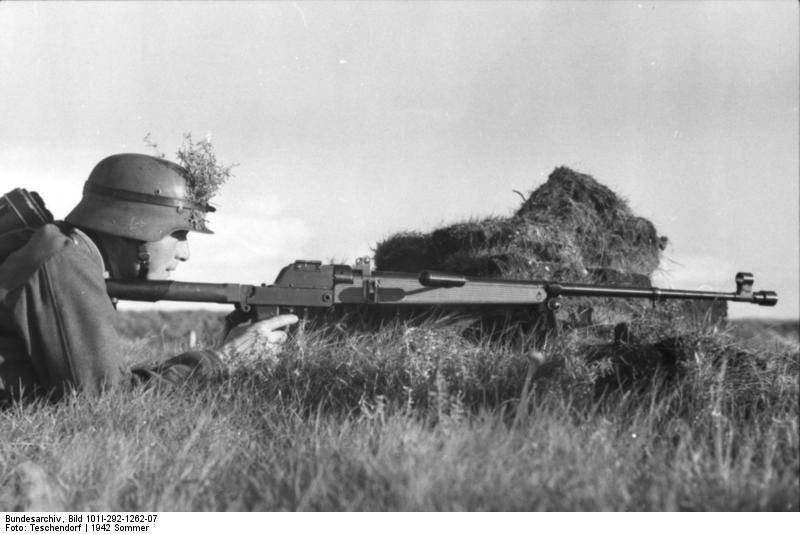
An interesting design of the Czech shop 7,92-millimeter anti-tank gun under the same cartridge, known under the designation MSS-41, which appeared in the 1941 year and used by the Wehrmacht. The anti-tank gun was manufactured at Waffenwerke Brünn (Česká Zbrojevka). The store was located behind the pistol grip. The reloading was done by moving the barrel back and forth. The bolt was part of the fixed butt plate, engaging with the barrel coupling that was planted on the barrel with a thread. The rotation of the coupling occurred by moving the pistol grip forward and upward. Further movement of the handle barrel moved forward. The perforated casing served as a guide for the barrel with a sleeve. The barrel in the front position struck a projection on the slide of the reflector, and the reflector, turning, threw the sleeve down. During the return movement, the barrel “hit” the next cartridge. When turning the pistol grip down the barrel locked with a bolt. Impact mechanism - shock type. The platoon of the drummer took place during reloading. In case of a misfire, a special lever for cocking the drummer was provided - for re-descent there was no need to recharge. The trigger was assembled in the grip. On its left side there was a safety lever, which locked the clutch latch and the trigger pull in the rear position. Aim devices - front sight and sight - folding. On the trunk was attached active muzzle brake. Shop - sector-shaped, box-shaped, interchangeable, for 5 cartridges. To reduce the height of the weapon, it was attached to the left, down at an angle of 45 degrees. After the filing of the new cartridge, the rest were held with the help of the cut-off lever. On a hike, the butt with a pillow, a “cheek” and a shoulder pad was folded up. The anti-tank gun had folding bipod. For carrying there was a strap. The Czech anti-tank gun, having the same ballistic qualities as the Pz.B-39, was distinguished by its compactness: the length in the stowed position was 1280 millimeters, in the battle position - 1360 millimeters. However, the production of anti-tank guns was difficult and it did not spread. At one time it was used by parts of the SS troops.
Before the start of World War II, Germany had formulated requirements for a more powerful anti-tank rifle. Obviously, the experience of using 20 mm Oerlikon guns, the effectiveness of which was demonstrated in Spain in the fight against German and Italian tanks, played a role here. The most relevant German requirements were the 20 mm Zoloturn anti-tank rifle of the Rakale and Herlach systems, especially since it was based on a 20 mm aviation Erhard’s cannon, used in the First World War.
In the barrel there was a 8 right-side rifling. In automation, the recoil of the trunk was used during its short course. The barrel bore was locked when the clutch, which was installed on its breech, was rotated, and its protrusions behind the lugs of the longitudinal slide bolt were set. During the movement of the barrel and the bolt back when recovered, the protrusion of the clutch entered the inclined groove of the box, the clutch rotated and unlocked. The barrel of the gun stopped, while the shutter continued to move back, the liner was ejected, and the percussion mechanism was cocked. The reloading cycle ended under the action of a return spring. For reloading manually used swing arm located on the right side of the box.
The recoil of the 20 mm cartridge “Solothurn” (20x105 B) was partially absorbed by the active muzzle brake, the bipod assembly and the shock absorber on the back of the butt. Close to the center of gravity of the gun mounted folding bipod. For fixing the sight and additional support under the butt there was a folding support of adjustable height. On the left side of the box was horizontally mounted on 5 or 10 cartridges.
The anti-tank rifle from 1934 was produced by Waffenfabrik Solothurn AG under the designation S-18 / 100. It was in service in Hungary (36M), Switzerland and Italy. After the development of the long golden cartridge (20x138 B), which has more power, the S-18 / 1000 rifle model was developed for it. Somewhat modified by Rhinemetal-Borsig, this 20-mm anti-tank gun under the designation Pz.B-41 was adopted. The gun had a jet muzzle brake. A small amount of Pz.B-41 was used on the Eastern Front and in the Italian Army.
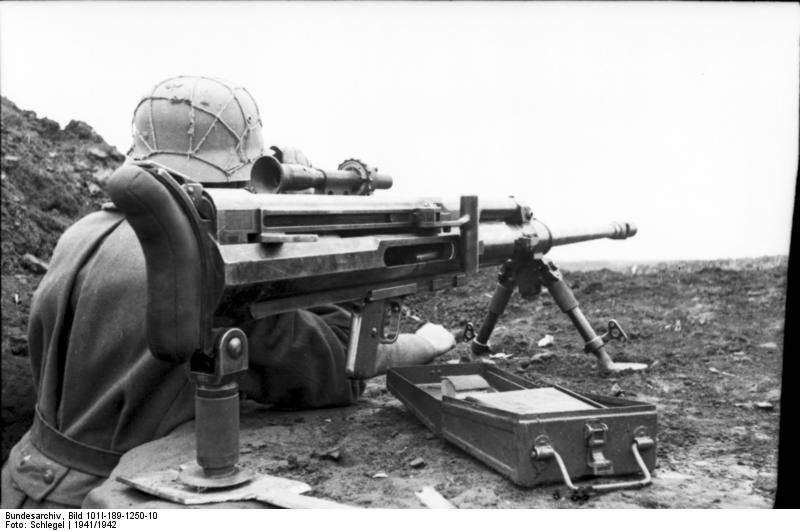
Already during the fighting in Europe against the British and French troops in 1940, the Germans were convinced of the need to strengthen anti-tank infantry weapons - this was suggested by the British Mk II “Matilda” tanks. In the first months of the war against the Soviet Union, the ineffectiveness of the 7,92-mm anti-tank gun against KV and T-34 became apparent. Already in 1940, the German Armaments Office intensified work on more powerful and at the same time relatively light anti-tank weapons. At the end of the 1941, the so-called “heavy anti-tank rifle” 2,8 / 2 cm s.Pz.B-41 (not to be confused with the PN.B20 “Solothurn” 41-mm rifle) was adopted by the Wehrmacht; the trunk. On the Soviet-German front, this gun was captured in the winter of 1942, the British captured it in May of 1942 in North Africa. This anti-gun was the implementation of the scheme, previously worked out theoretically and experimentally. The design of a conical bullet that implemented the “principle of cork and needle” (a small lateral load in the barrel and a high load on the trajectory) suggested Beck in Prussia as early as the 60 of the 19th century. In 1905, a rifle with a conical bore, tapering to the barrel, a special form bullet and special rifles was offered by the Russian inventor Druganov and calculated by General Rogovtsev, and in 1903 04 a patent for a rifle with a conical barrel was obtained by German professor K. Puff. Extensive experiments with a tapered barrel were carried out by engineer G. Gerlich in 20-30-s. He even tried to release his "super-screw" to the market at first as a hunting rifle, and later as an anti-tank rifle. The design of the Gerlich anti-tank rifle barrel had a conical section and cylindrical segments in its breech and muzzle. The cuts (the breechs at the deepest) went down to the muzzle slice. This allowed a more rational use of the pressure of the powder gases necessary to disperse the bullet. This was done by increasing the average pressure at the same maximum. The initial speed of a bullet in an experienced 7-mm anti-tank gun of the Gerlich system was up to 1800 meters per second. The projectile (Gerlich in his advertising articles called him “ultra-bullet”) had crushable leading belts. When moving along the bore, they were pressed into special recesses on the projectile. The high lateral load of the bullet ejected from the barrel bore provided a high penetrating action and maintaining speed throughout the entire flight path. The works of Gerlich at that time attracted general attention, but even in Germany they were little used in practice. In Czechoslovakia at the end of 30's H.K. Janáček based on Gerhlich’s “ultra-principle” created an anti-tank rifle of millimeter 15 / 11. After the seizure of Czechoslovakia, prototypes of these anti-tank guns fell into the hands of the invaders, but did not arouse interest.
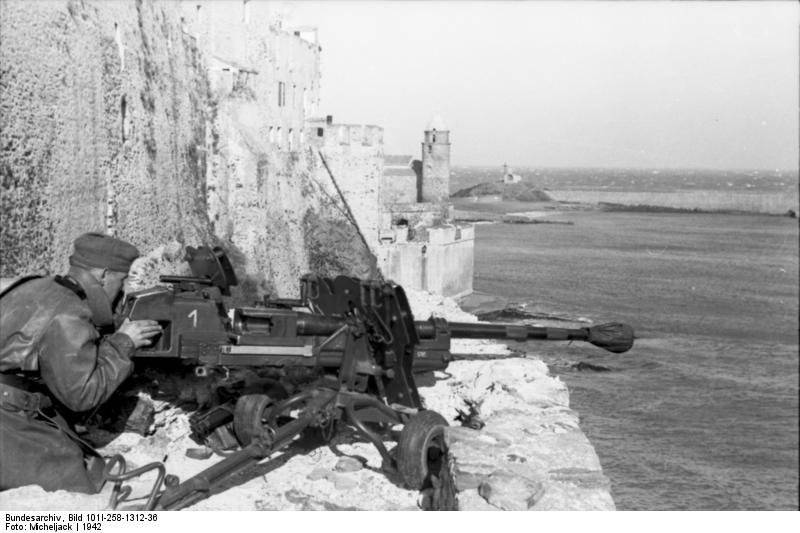
Since the quality of armor was improved by 1940, and the thickness of the reservation of cars has increased significantly, we had to resort to large calibers. The caliber of the s.Pz.B-41 was in the breech - 28 millimeters, in the muzzle - 20 millimeters, with a length 61,2 caliber. In the barrel there were two conical transitions, that is, the projectile was crimped twice. The barrel was equipped with an active muzzle brake. In the massive breech there was a nest for a wedge horizontal shutter. The anti-tank gun was supplied with a kind of gun carriage (like an artillery gun) with a rotary top machine. There were sliding beds with folding bipods and stamped wheels with rubber tires. The barrel with the bolt and the breech slid in the guides of the cradle, fixed in the sockets of the upper machine tool on the pins. The upper machine was connected to the lower combat pin. The absence of a lifting mechanism eased and simplified the design. A small flywheel was used to operate the turning mechanism. The elevation angle was up to + 30 °, the horizontal guidance was up to ± 30 °. The rate of fire was up to 30 shots per minute, which depended on the working conditions and the training level. Weapons equipped with a cover in the form of a double shield. In its left part from above the cut necessary for an aiming became. Optical sight, rendered to the left, also had a double shield. The total mass of the system was equal to 227 kilograms, that is, twice less than the 37-mm anti-tank cannon Cancer 35 / 36 which weight was 450 kilogram. "Heavy anti-gun" was purely positional - that is, placed on specially prepared positions - anti-tank tool. However, the appearance of these weapons at the front was one of the reasons forcing the Soviet tank builders to again raise the issue of improving armor. Soviet troops in January 1944 seized another version of s.Pz.B-41, which had a kilogram weight of 118. This was done by making changes to the installation - the one-bottomed lower machine was equipped with a tubular bed and stamped poloski, small wheels were installed. The carriage provided circular horizontal guidance (at the maximum elevation angle - in the 30 ° sector), and vertical - from -5 to + 45 °. The height of the line of fire ranged from 241 to 280 millimeters. s.Pz.B-41 for carrying disassembled into 5 components. The main shield was often shot for better camouflage.
For s.Pz.B-41, they created a unitary cartridge having an 28cm Pzgr.41 armor-piercing-fragmentation projectile (125 mass grams) with a steel armor-piercing core and an aluminum sharp cap (Gerlich’s bullets didn’t have such a core). The overall design of the projectile complied with the patent of Gerlich 1935 of the year - with two belts having the shape of a conical skirt and an undercut. In the front girdle, there were five holes that supposedly contributed to the symmetric compression of the girdle. 153-gram charge of pyroxylin powder (tubular grain) of progressive burning ensured an initial velocity of the projectile equal to 1370 meters per second (that is, near 4M - and today "hypersonic" anti-tank shells are considered the most promising means). The cartridge had a brass sleeve sleeve 190 long millimeters with a protruding flange, the primer cap was C / 13 nА. The total length of the projectile was 221 millimeter. The armor penetration of s.Pz.B-41 using an armor-piercing projectile was at a distance of 100 meters - 75 millimeters, 200 meters - 50 millimeters, 370 meters - 45 millimeters, 450 meters - 40 millimeters. Thus, having a smaller size and weight, the “heavy anti-tank gun” in terms of the effectiveness of the fight against armored vehicles was comparable to the 37-mm anti-tank gun. Since the "heavy anti-tank gun" was essentially an infantry weapon, a fragmentation cartridge with an 28cm grenade Spgr.41 (grenade weight - 93 gram, explosive charge - 5 gram) with a propelling charge 139 gram, head fuze device, 41 gram, with a missile explosive - 12 gram, with a propellant XNUMX gram, head fuze device, XNUMX gram, with a missile charge XNUMX gram, with a missile explosive - XNUMX gram, with a missile charge XNUMX gram, head fuze device . Sleeve and total length matched s.Pz.B-XNUMX. Cartridges were sealed in metal trays of XNUMX pieces.
In addition to the 28 / 20-millimeter anti-tank rifle, anti-tank guns with a “conical” barrel bore - 42 / 22-millimeter 4,2cm.c.pdf. X.H.H.X.H.X.H.X.H.X.H. X.H. X.H. 41 kilogram). These guns had good ballistic indicators, but the production of systems with a "conical" barrel was expensive and technologically difficult - a property that was inconvenient for anti-tank weapons of the leading edge. Also, the "conical" barrel had a low survivability. The sabot projectile solved the same problems with great success even with “traditional” trunks. The adoption of sub-caliber coil shells to the standard 560-mm and 75-mm anti-tank guns had a greater effect, so in 55, the production of guns with a conical barrel was stopped. In those years, it was not possible to work out the design of the sabot bullet, therefore the anti-tank guns did not receive such cartridges.
Before the war, a shop-based anti-tank gun, developed by Captain Boyce, who served as Assistant Chief of the Royal Small Armz design bureau in Enfield in 1934, entered the British Army. Initially, the gun was developed under the 12,7-mm cartridge "Vickers" for heavy machine gun. The development was carried out within the framework of the work of the British Light Weapons Committee under the code designation “Stanchion” (“Stanchion”). The anti-tank rifle, after being put into service, received the designation Mkl “Boyes”. Its caliber has been increased to 13,39 millimeters (".550"). The cartridge was equipped with an armor-piercing bullet with a steel core. Beginning with 1939, each anti-tank platoon was armed with one anti-tank rifle. Since the end of 1936, the Boys rifle has manufactured the BSA (Birmingham Small Arms) plant in Birmingham. The first order was fulfilled only at the beginning of 1940, after which a new order was immediately received. It was reported that Royal Small Arms and Boyes also participated in the production.
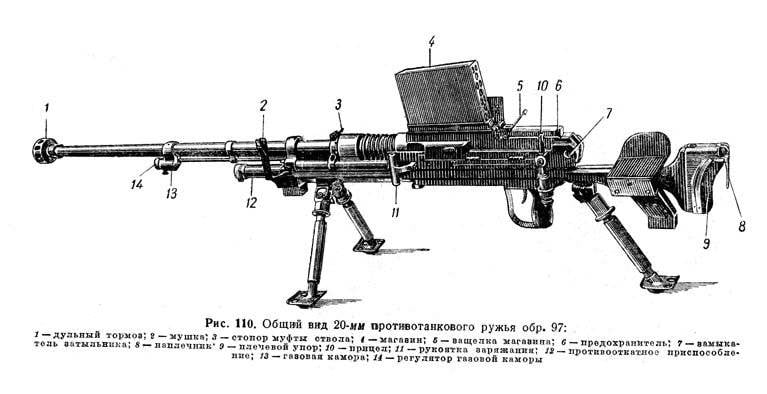
The anti-tank gun consisted of a barrel and a receiver, a frame with a foldable bipod, a magazine, a bolt, and a back plate. The barrel bore had 7 right-sided rifling. Box-shaped muzzle brake attached to the muzzle of the barrel. The barrel in the receiver was mounted on the thread. When fired, they shifted somewhat along the frame, and absorbed some of the recoil energy, compressing the shock absorber spring — such a combination of an “elastic mast” and a muzzle brake, borrowed from artillery systems, reduced the recoil effect and prevented the recoil from jumping. The barrel was locked when a longitudinal slide bolt rotated in front of which had six lugs in three rows and a curved handle. In the gate was assembled drummer equipped with a ring, coil spring coil, reflector and non-rotating ejector. Holding the ring, the drummer was placed on a safety or combat descent. Hammer to the drummer fastened coupling.
The anti-tank gun had a trigger of the simplest type. On the left side of the receiver was a safety lever that locked the drummer in the rear position. Left-handed sights included a front sight and a sight with the installation of a 300 diopter, 500 meters, or only 300 meters. Box-shaped single-row store was installed on top. Pistol grip had a forward bend. On the metal back plate there was a rubber shock absorber, on the left side there was a “cheek”, a handle, and an oil can was placed in it. Bipod T-shaped. Also met anti-gun with a "two-legged" folding bipod. The “Boyce” rifle was carried by one soldier behind his back on a gun belt.
For the first time, the “Boys” anti-tank guns were used in combat conditions not by the British, but by the Finnish army - the United Kingdom quickly put these guns to Finland during the Soviet-Finnish war of 39-40. In the 1940 year, a bullet with a plastic lead band and a tungsten core was inserted into the 13,39-mm cartridge, but they were used limitedly, probably because of the high production cost. Army orders for Boyes anti-tank rifles were issued until January 1942, by which time guns had become ineffective. However, in the 1942, the model released "Boyce" Mkll having a shortened barrel and intended for the Airborne Forces. In the same year, an experimental model “Boys” was produced with a conical borehole drilling (probably influenced by Polish German works), but it did not go into series. Total released about 69 thousand. "Boyce", some of which were supplied to Canada and the United States.
In place of the anti-tank guns "Boyce" in service with the British army were adopted PIAT grenade launchers. "Boyce" also transmitted to the Polish units in the British Army. Approximately 1,1 thous. put under the Lend-Lease of the Red Army, but they did not enjoy success. At the same time, the German troops used the captured "Boyes" very willingly. It should be noted that the Czech designer Janacek, who had moved to England during the war, developed the Little DJon conical muzzle for firing small-caliber anti-tank guns and regular magazine rifles with special projectiles and armor-piercing bullets, but this device was not used in combat.
At the start of the war in the United States, an 15,2-mm anti-tank rifle with an initial speed of a bullet at 1100 meters per second, later an 14,5-mm anti-tank rifle, which was proposed to install an optical sight, was tested. During the Korean War, they experienced - albeit unsuccessfully - an 12,7-millimeter anti-tank gun.
Now consider the foreign "minimum artillery" caliber anti-tank guns. Heavy 20-mm self-loading anti-tank guns were in service with the armies of Germany, Finland, Hungary, Japan.
Swiss 20-millimeter self-loading anti-tank gun "Oerlikon" used by the Wehrmacht created on the basis of "anti-tank machine gun" of the same company. In automatics, the recoil of a massive free shutter was used. The gun had a shop supply (again, the German scheme of the Becker gun was taken as a basis). The weight of the anti-tank gun was equal to 33 kilograms (which made it the lightest in this class), the length of the gun was - 1450 millimeters with a barrel length - 750 millimeters. The initial speed of the 187-gram "bullet" - 555 meters per second, armor on 130 meters - 20 millimeters, on 500 meters - 14 millimeters. In addition to armor-piercing cartridges used with lighting, incendiary and high-explosive fragmentation projectiles - ammunition borrowed from a gun.
The Japanese Type 97 anti-tank rifle (i.e., the 1937 model of the year — it was 2597 from the founding of the Empire, according to Japanese chronology; the anti-tank rifle is also known as Kyana Shiki) based on an aviation automatic cannon. It was developed for the cartridge "Type 97" (20x124), which had two options - with fragmentation and armor-piercing shells.
The anti-tank gun consisted of a barrel, a receiver, a moving system (bolt carrier, wedge, bolt), a ballast, a magazine and a machine-cradle. The principle of removal of powder gases was used in automation. In the middle of the trunk there was a vapor chamber and a regulator on the 5 positions below. Chamber tube connected to the gas distributor. An active-reactive muzzle brake mounted on the barrel was made in the form of a cylindrical box with longitudinal slits. The connection of the barrel and receiver - rusk. Vertically moving wedge bolted the barrel bore. A characteristic feature of the system is a bolt carrier with two reciprocating springs and piston rods. The reloading handle was located on the upper right and was carried out separately. In the receiver housed the bolt delay, which is turned off when you attach the store. The anti-tank rifle had a percussion impact mechanism. The drummer received a boost from the bolt rack through an intermediate piece located in the locking wedge. The trigger, assembled in the trigger box of the machine, included: sear, trigger lever, trigger, trigger pull, and disconnector. Flap fuse located in the back of the receiver, blocked the drummer in the upper position. The barrel and receiver moved along the cradle-machine on the length of 150 millimeters. An anti-recoil device was placed in its groove, which included two coaxial coil springs and a pneumatic recoil brake. The anti-tank rifle was able to fire in bursts (therefore, in our press it is sometimes referred to as the “heavy machine gun”), but it had too low accuracy.
Aim devices - a stand with a diopter and a front sight - were placed on brackets to the left. The brackets were attached to the cradle. From above the box shop fastened. The cartridges were staggered. The shop window was covered with a lid. A butt with a rubber shock absorber, a shoulder pad and a “cheek”, a left-hand grip and a pistol grip were attached to the cradle. Support created rear adjustable support and bipod, height adjustable. Their position was fixed with locking sleeves. In the cradle there were two sockets for connecting the “two-horned” tubular carrying handles - front and rear. With the help of the arms, the anti-tank gun could be carried by three or four fighters. A removable shield was developed for the anti-tank rifle, but it was practically not used. The gun was fairly stable in position, but it was difficult to maneuver fire on the front. The cumbersome "Type 97" is usually used in defense. Calculations preferred to work on previously prepared positions with rigorous lines and points. Two anti-tank guns were part of a machine gun company of an infantry battalion. The infantry division had less than 72 anti-tank guns - not enough for effective action against the enemy, having a large number of armored vehicles.
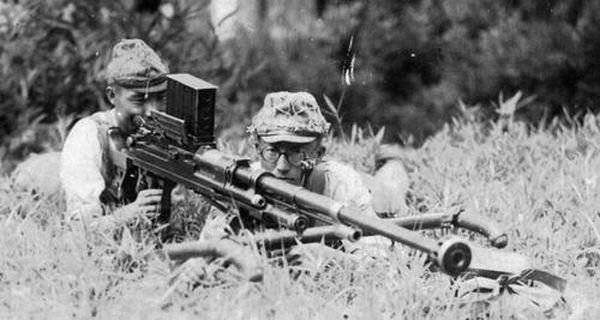
Soviet tankers encountered the 97 Type Japanese anti-tank guns as early as 1939 at Khalkhin Gol. Subsequently, their limited use on the islands of the Pacific Ocean. There, they showed good results in the fight against American landing armored personnel carriers and light armored vehicles, but they proved ineffective against medium tanks. Anti-tank gun "Type 97" was designed to compensate for the lack of anti-tank artillery, but it was released in a relatively small number, so it did not solve the problem. The anti-tank grenade launchers and anti-tank guns developed by the end of the war did not have time for Japanese industry to put on production.
The Finnish anti-tank gun L-39 was developed by Aymo Lahti. They took as their basis their own aircraft gun of the 1938 model. The cartridge (20x138) was reinforced. Automatics L-39 was also built on the system of removal of powder gases. The anti-tank gun consisted of a barrel having a gas chamber, a flat muzzle brake and a perforated wooden casing, a trigger frame, a receiver, trigger, impact and locking mechanisms, sighting devices, a magazine, a back plate and a bipod. Gas chamber - closed type, with a guide tube and a gas regulator (4 position). The barrel and receiver were connected with a nut. The clutch bolt with the receiver - a vertically moving wedge. Unlocking and locking was done by bolts of the bolt, which was made separately from the rod with the piston. drummer with a mainspring, rammer and ejector mounted in the gate. The swinging reload knob was on the right.
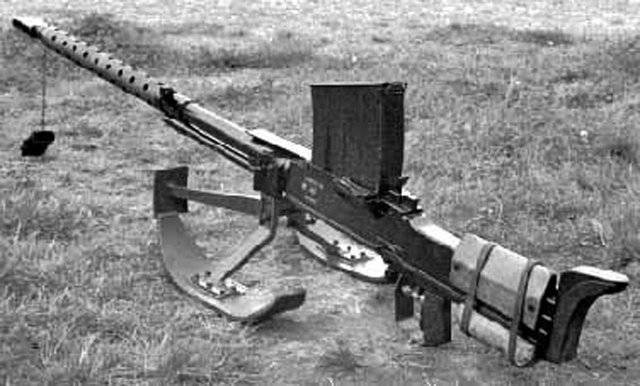
A distinctive feature of the Finnish anti-tank rifle was two trigger mechanisms: the rear one - to keep the mobile system on combat platoon, the front one - to keep the drummer. Before the pistol grip, inside the trigger guard there were two triggers: the lower one for the rear trigger mechanism, the upper one for the front trigger mechanism. Flap fuse located on the left side of the receiver in the front position blocked the trigger lever of the front trigger mechanism. Sequential descent at the beginning of the moving system, and then the striker prevented a random shot, and also did not allow too fast firing. The sights included a sector-mounted sight placed on the receiver and a front sight on the trunk. The box-shaped sector shop, which has a large capacity for an anti-tank gun and the staggered arrangement of cartridges was attached from above. On the march the shop window was closed with a flap. The back plate was equipped with a height-adjustable rubber shoulder rest and a wooden lining - “cheek”. On a hike, the bipod-bipod was separated from the gun and was also equipped with skis. The bipod knot included a small balancing spring mechanism. The stops facing forward could be fastened with screws on a bipod — they used an anti-tank rifle to rest on a knoll, a parapet of a trench, and the like. In the design of the anti-tank gun, one can see an account of the specific northern conditions of operation - a minimum of holes in the receiver, a shop window shield, on the bipod of a ski, a wooden casing located on the barrel, convenient for carrying in cold weather.
The anti-tank rifle from 1940 to 1944 was produced by the state-owned company VKT. Total was released 1906 anti-tank guns. Since 1944, the L-39 has moved into the category of "auxiliary" air defense weapons - this has befallen many anti-tank guns. In the USSR, attempts were also made to create more powerful anti-tank guns of "artillery" calibers, but this path of "integration" was already unpromising. In 1945, A.A. Blagonravov, a major domestic gunsmith, wrote: “In its current form, anti-tank guns have exhausted their capabilities ... The most powerful (20-millimeter RES), which are on the verge of growing into artillery systems, are not able to effectively deal with modern self-propelled guns and heavy tanks ".
Note that this conclusion applied to this type of weapon as an anti-tank weapon. After the war, the “niche” of anti-tank guns on this plane was firmly occupied by anti-tank anti-tank grenade launchers - they were not accidentally called “anti-tank anti-tank guns”. But in 80, a kind of revival of anti-tank guns in the form of large-caliber sniper rifles began - during World War II, they tried to equip anti-tank rifles with optical sights for use at long distances. Large-caliber rifles of this type are designed either to defeat manpower at a considerable distance, or for assault actions (short-barreled models), or to hit point targets (reconnaissance, control and communications equipment, protected firing points, satellite communications antennas, radar, light armored vehicles, vehicles means, UAV, hovering helicopters). The latest type, which is the closest to the previous anti-tank guns, include American 12,7 millimeter graphics systems M82 A1 and A2 Barret, M88 software, McMillan, Hungarian 12,7-mm mm Heptard M1, and ICNUM software systems in Hungarian 14,5-mm mm Heptard M3 and software systems in German XMNUMX systems, Hungarian 12,7-mm mm "Cheetah" M96 systems, NXMX, and Hungarian 15-mm mm "Cheetah" M2000 and XMIHPS systems that are in the Hungarian 20-mm model "Cheetah" M1942 and YNXX-YC systems which are the same; millimeter OCB-14,5 and KSVK, Austrian 64-millimeter IWS-28, South African 20-millimeter NTW. In this type of small arms, approaches are often used, spent anti-tank guns - cartridges are borrowed from aircraft guns or large-caliber machine guns, or are specially developed, some constructive features resemble anti-tank guns of World War II. The attempts made during the Second World War to use anti-tank guns as weapons of light armored vehicles were interesting. For example, in 41, the 221-mm anti-tank gun instead of machine guns was installed on a batch of BA-20 (USSR) light armored vehicles, the German 36 / 13,39-mm s.Pz.B-XNUMX was installed on a light biaxial Sdkkkf.kz.B. ), XNUMX-mm XNUMXM “Solothurn” - on a light “Turan I”, English XNUMX-millimeter “Boyes” - on the tank Mk VIC, armored car “Humber MkIII” and “Morris-I”, tracked armored “Universal”, narrow-armed ones armored trains of territorial defense. The Universal's armored personnel carrier equipped with an anti-tank rifle “Boyce” was delivered to the Soviet Union as part of a lend-lease.
Almost all of the pre-war manuals and statutes recommended concentrated machine-gun and rifle fire on tanks - according to the experience of the local wars of the 20-ies and the First World War - as a rule, on the viewing slots from distances up to 300 meters. Such a fire really played a purely supporting role. During the Second World War, the Red Army abandoned the selection in the defense of riflemen with automatic rifles and groups of machine guns to fire tanks - small arms were needed primarily against manpower, and shelling tanks did not give the desired effect even when using armor-piercing bullets. The available rifle cartridges with armor-piercing bullets of normal caliber pierced the armor up to 10 millimeters at a distance of 150-200 meters and could only be used for firing at shelters or light armored vehicles. For example, US Army General M. Ridgeway recalled how in the Ardennes he managed to knock out a light German ACS from an 15 meter with a Springfield rifle with an armor-piercing bullet while the nearby grenade launcher was messing with a bazooka clogged with snow.
The source of information:
The magazine "Equipment and weapons" Semen Fedoseev "Infantry against tanks"
Information